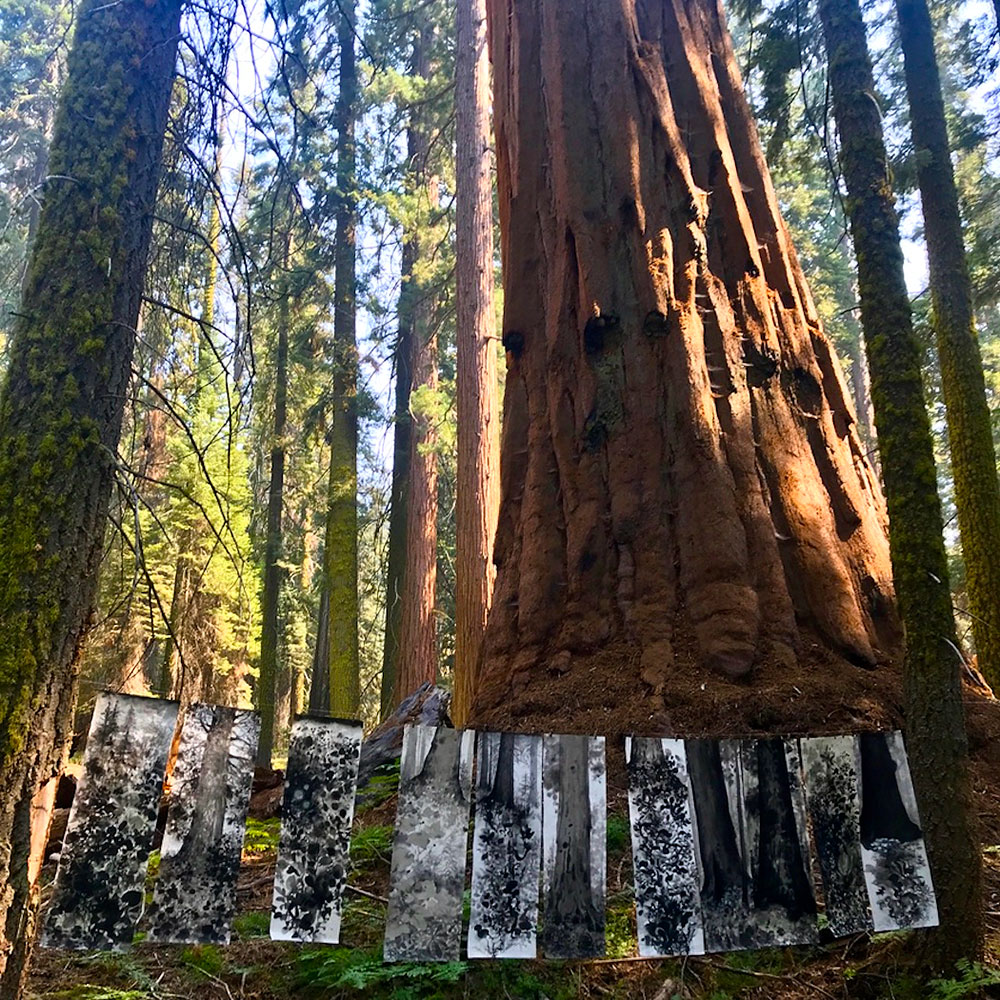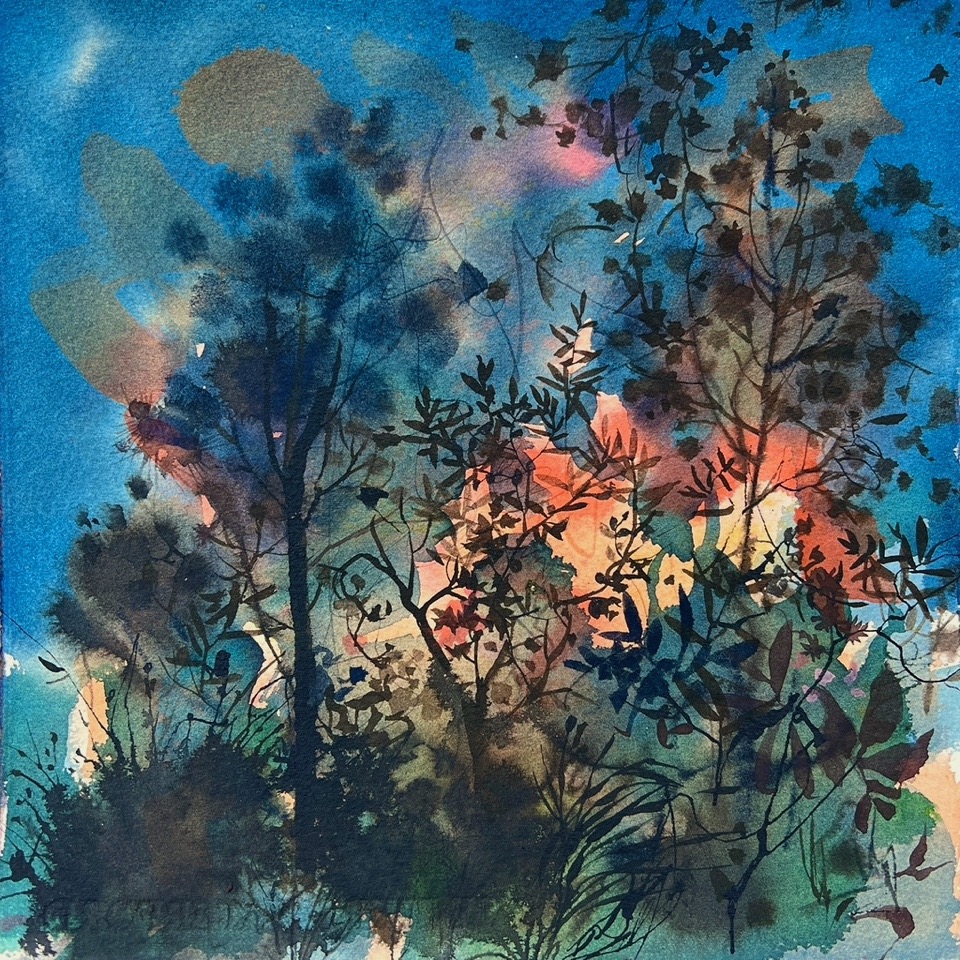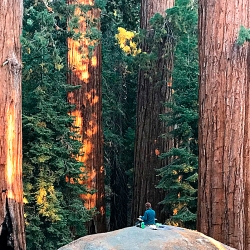Painting Forest Prayer Flags
Dates: July 21-26, 2024
Instructor: Andie Thrams
Fee: $560.00
Term: Summer 2024
Workshop Description
This course shares the watercolor, ink, and acrylic painting practices I use in my ongoing project, ForestSong. We'll all create paintings and Forest Prayer Flags on paper and canvas to evoke what is seen and experienced beneath the trees in and around the Field Campus. We’ll also collaborate to make Forest Prayer Flags to donate to Sierra Nevada Field Campus.
This project, and our class, employs empowering step-by-step processes using watercolor and acrylic to delve into biophilia—that rich human pleasure that comes from being surrounded by living organisms. The work also uses dark ink and wildfire charcoal to effectively address our solastalgia—that very particular emotional pain produced by environmental degradation in places we experience as home and/or as beloved.
Both joy and sadness will be invited into our creative work through quiet reflection and careful observation. To address how climate change impacts our forests, including their appearance, contemporary Sierra Nevada forest and wildfire ecology will be shared. It is a human paradox that addressing climate anxiety and habitat loss can enliven resilience, rekindle joy, and inspire effective action.
Our work will bear witness to forest beauty, document experiences, record wonder, grapple with the unique grief of our era, and deepen our connection to earthly beauty and to each other. Basic painting and color mixing experience is helpful, but all levels are invited. I hope you’ll join me in this project!



Instructor Bio
Sierra Nevada-based artist Andie Thrams creates paintings and artist’s books in wildland forests to explore mystery, reverence, and delight, while also grappling with the vanishing habitats of our era. Merging the lineages of illuminated manuscripts and natural history field journals with contemporary art and science awareness, her work weaves rich layers of watercolor, intricate botanical detail, and hand-lettered text to evoke the complex interconnections within ecosystems of the Greater West. Her work is held in many public and private collections, is regularly exhibited, and has been honored by institutions including Sitka Center for Art & Ecology and Yosemite Renaissance. She lives in a small river town in the Sierra Nevada foothills with her husband. Learn more on her website: www.andiethrams.com Contact Andie by email: andie@andiethrams.com
Workshop Details
Workshop Schedule
Please plan to arrive at the Sierra Nevada Field Campus well before dark and early enough Sunday afternoon to allow yourself plenty of time to settle into your campsite and come to dinner, served nightly at 6 pm. We’ll meet informally Sunday night during and immediately after dinner for orientation, Q&A, and a brief art supplies discussion. Please bring all your supplies for our first class, which will begin at 9 am Monday morning. Each morning, we’ll gather to discuss our plans for the day. We’ll be out in the field most days for varying amounts of time, walking local trails no more than a few miles from our cars over gentle terrain. We’ll return to camp each day to allow time to relax before dinner. I usually paint outdoors in the lovely evening light after dinner, and all are invited to join me during these optional meditative moments. Our course will end after lunch on Friday, by 2:00 p.m.
Workshop Supplies List
Workshop Art Supplies
- In addition to the supplies listed below, I will have some watercolors, acrylics, ink, paper, and canvas to share during our course. Please bring $20 to cover these additional materials. I will also have a few extra supplies on hand available for purchase.
- If you don’t already have all the materials on this list, just bring what you can.
- See my website for detailed art supply recommendations.
- Be sure your day pack will hold your art supplies, lunch, water, extra clothing layers, etc.
Paper
- Two or three full-size sheets 140 lb. hot press and/or cold press watercolor paper. I like Arches, Fabriano, and Saunders best.
- Before coming, cut or tear your sheets into six roughly equal pieces measuring 10 X 11 inches each. (One full-size sheet of 22 x 30 inch watercolor paper yields six 10 X 11-inch pieces.) We will not have the space or tools to do this on site, so be sure you do this before class!
Brushes
- #10 (or bigger) and #6 round watercolor brushes
- Large Pentel water brush
- Large flat (2 inches or so) cheap craft or house painting brush
- Round and/or flat brushes for ink and/or acrylic (best to use different brushes from the ones you use for watercolors)
- Optional other useful brushes: 1/4-inch angle shader, 1-inch flat watercolor brush, stiff bristle brush of any type, a script or rigger or liner brush, and any other brushes you like
Ink & Paint
- Any type of black or brown ink (sumi if you have it)
- If you have some, bring acrylic ink or paint in any three colors you like (I’ll have some to share, so don’t worry if you don’t have any)
- Folding palette with mixing space (4x9 inches is a good size—opens to 8x9)
- Fill your palette wells with tube watercolor paints in the following recommended colors:
1. Quinacridone rose or pink
2. Ultramarine blue
3. Pthalo or manganese or cerulean blue
4. Lemon yellow or cadmium yellow pale or hansa yellow light
5. Cadmium yellow deep
6. Sap green
7. Chromium oxide green
8. Any purple
9. Any orange
10. Burnt sienna and/or burnt umber
11. Permanent white gouache (not watercolor)
Other
- One lightweight board, such as foam core, mat board, corrugated plastic, thin wood, etc., measuring about 12 X 12 inches, to hold your paper.
- Clips to fasten paper to your board
- No. 2 or HB drawing pencil
- Pencil sharpener
- Kneaded eraser
- Black felt tip pen (such as Pigma micron in size .01)
- Small ruler
- Colored pencils: cream and/or a light grey
- Eye dropper
- Zip lock or other bag for collecting leaves, twigs, etc.
- Small mixing containers to hold ink and paint
- Small spray bottle
- Rags or paper towels
- Small notebook or sketchbook or journal for notes and trying out ideas
- Sit-upon, folding stool, or whatever you need to paint outdoors comfortably (I like to bring a lightweight tarp to spread out on the ground and sit on an ensolite pad).
Lodging and Camping Supplies
Camping gear if you are staying on campus:
- tent and sleeping pad (unless you are staying in our tent with a cot provided)
- warm sleeping bag
- pillow, toiletries, and towel
- flashlight and lantern
- alarm clock
Field gear for everyone:
- day pack
- sunscreen
- insect repellant
- water bottles
- plastic containers for packed lunches
- sense of humor
You might also want to bring:
- camera
- binoculars
- hand lens
- camp chair
Clothing:
The weather in the Sierra Nevada can vary greatly, even in a single day. Be prepared for chilly temperatures at night, even below freezing early in the summer. Rain is a possibility any time, whether forecast or not. Variable weather clothing that can be layered is best: long pants and a long-sleeved shirt, warm sweater and jacket, t-shirt and shorts or skirt, sturdy shoes or hiking boots, sun hat, rain gear, and a warm hat or gloves for cold weather and/or night activities. And, if you come later in the season, bring your swimsuit for afternoon dips in the lakes!